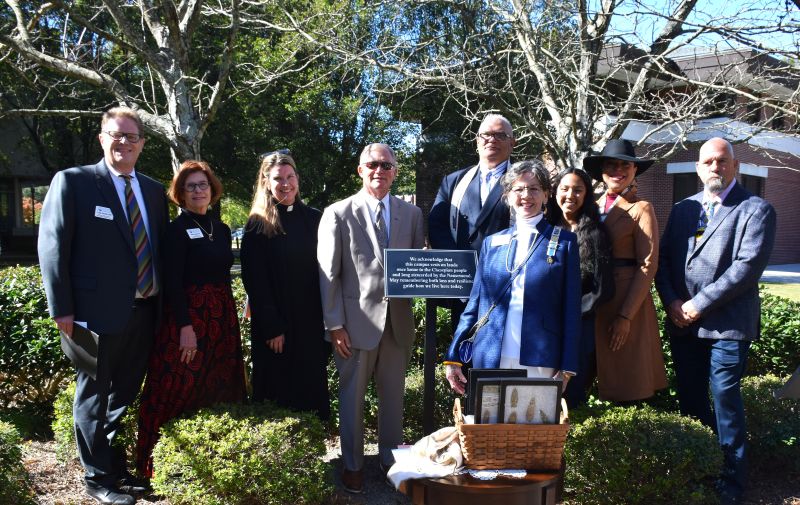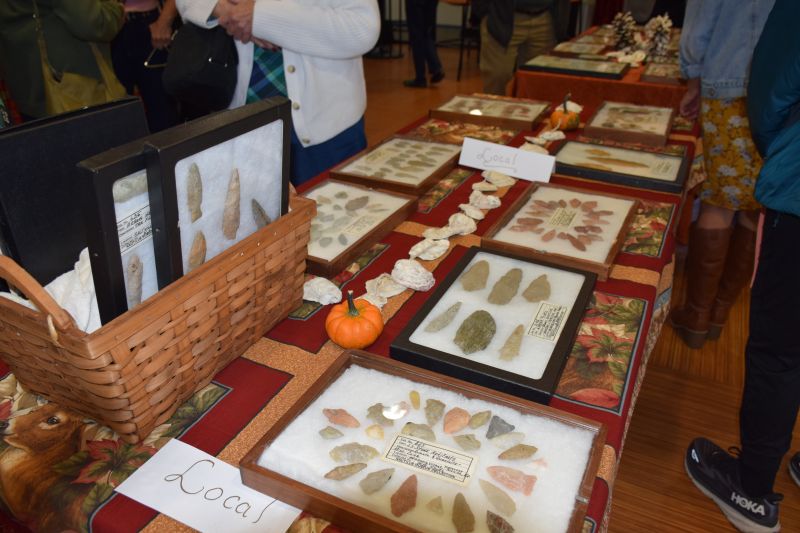Share this Story
The Stories Beneath Our Feet
Honored traces of the past returned to the Nansemond Indian Nation during repatriation ceremony
University News | October 27, 2025
 Just seventy years ago, before the land became home to Virginia Wesleyan University, it was farmland. Before that, it was a haven for newly emancipated Black Americans seeking to build new lives in freedom. And long before any of that, it was part of the ancestral homeland of the Nansemond people—members of the Powhatan Confederacy who lived in longhouses near the region’s winding waterways.
Just seventy years ago, before the land became home to Virginia Wesleyan University, it was farmland. Before that, it was a haven for newly emancipated Black Americans seeking to build new lives in freedom. And long before any of that, it was part of the ancestral homeland of the Nansemond people—members of the Powhatan Confederacy who lived in longhouses near the region’s winding waterways.
As part of the Robert Nusbaum Center’s semester-long exploration of legacy, the campus community gathered with members of the Nansemond Indian Nation for a moving repatriation ceremony on October 23. The event honored the return of ancestral artifacts that had been in the university’s care for nearly sixty years—a gesture that acknowledged not only the past but also the enduring presence and living heritage of the Nansemond people.
The ceremony took place in Virginia Wesleyan’s Peace Garden, where the Rev. Dr. Craig Wansink, director of the Robert Nusbaum Center, welcomed attendees.
“The ground beneath us and around us has known many stories,” Wansink shared. “Seventy years ago, this was farmland. Before that, in the 1860s, it was home to newly emancipated Black families finding a new way of living. And long before that, this land was part of the ancestral homeland of the Nansemond people—members of the Powhatan Confederacy who built longhouses near the waterways, spoke Algonquian languages, and left traces of their lives here: beads, arrowheads, pipes, spear points, even jewelry.”
 Wansink explained that nearly sixty years ago, when Virginia Wesleyan was newly established, former realtor and high school principal Lyn Good donated his collection of Native American artifacts to the college. The pieces—some dating back as far as 7,000 years—had once been displayed at Kibler’s Museum at the Nauticus Shell Shop and later used by VWU students to study North American cultures.
Wansink explained that nearly sixty years ago, when Virginia Wesleyan was newly established, former realtor and high school principal Lyn Good donated his collection of Native American artifacts to the college. The pieces—some dating back as far as 7,000 years—had once been displayed at Kibler’s Museum at the Nauticus Shell Shop and later used by VWU students to study North American cultures.
“Today, we have the chance to do something better,” Wansink continued. “To return these objects to the descendants of those who once called this place home. This moment is about gratitude and honesty. It’s about recognizing that education means more when it’s rooted in respect and relationship. That’s what this act of return represents.”
Representatives of the Nansemond Indian Nation joined the ceremony, including Chief Keith Anderson, Assistant Chief Nikki Bass, and Council Treasurer Thomas Badamo, who also serves as president of the only Native American–led chapter of the Sons of the American Revolution.
Chief Anderson offered remarks on behalf of the Nansemond Indian Nation:
“We are very grateful for this day—a day that honors the connection between our ancestors, this land, and all who now call it home. Returning the artifacts reminds us that our stories have never vanished; they were always here, carried in the land, the water, and the hearts of our people. What is being returned today is more than history—it is spirit, presence, and continuity. Our ancestors’ hands shaped these tools, but it is their wisdom that still shapes us. When we speak of repatriation, we are speaking of healing—of restoring what was separated and remembering what was forgotten.”
Following Chief Anderson’s remarks, VWU President Scott D. Miller ceremoniously returned the artifacts to the Nation’s representatives.
The program also included the dedication of a permanent land acknowledgment plaque in the Peace Garden, recognizing the Nansemond people as the original stewards of the land on which Virginia Wesleyan stands. Gabrielle Barnett, president of VWU’s Student Government Association, and Rev. Dr. Melissa Sumner Long, general presbyter of the Presbytery of Eastern Virginia, led the dedication. The plaque was made possible through the William Granville Sale, Jr. Award, given by the Presbytery’s Peacemaking Committee in honor of longtime member Bill Sale.
The driving forces behind this day, Kelly Jackson, associate director of the Nusbaum Center, and Jackie Murray of Old Donation Episcopal Church and the Lynnhaven Parish Chapter of the Daughters of the American Revolution, also shared reflections on the repatriation process and the partnership that made the event possible.
Following the ceremony, attendees were invited to The Lighthouse in Clarke Hall to view displays of Native American artifacts from across the United States—each a reminder of the deep, enduring connections between people, place, and history.
Learn more about the Robert Nusbaum Center at VWU.

